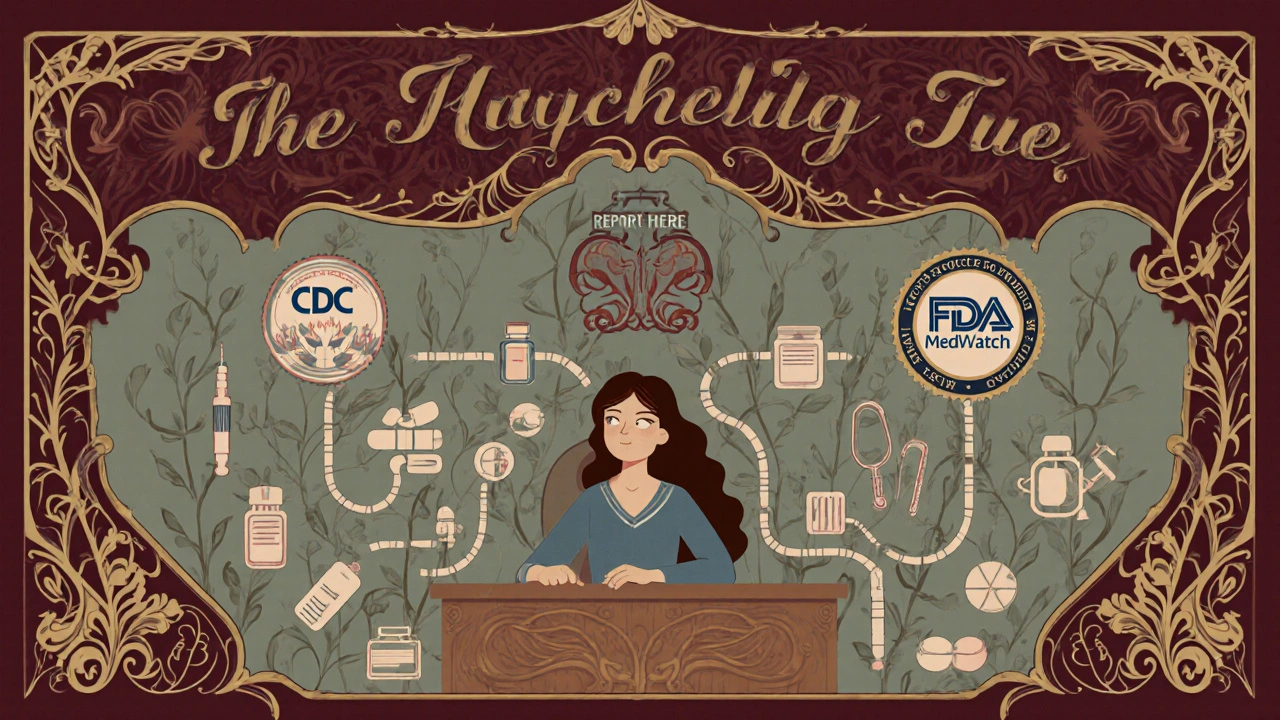MedWatch vs VAERS: How to Report Drug and Vaccine Side Effects Correctly

Nov, 26 2025
Every year, millions of people take prescription drugs or get vaccinated. Most do fine. But some don’t. When something goes wrong, who do you tell? And does it even matter which system you use?
If you report a bad reaction to a vaccine on MedWatch, your report won’t reach the right people. If you send a reaction to a blood pressure pill to VAERS, it gets lost in the wrong system. These aren’t interchangeable forms. They’re two completely different tools built for two completely different purposes - and mixing them up can slow down safety investigations.
What Is VAERS, Really?
VAERS stands for Vaccine Adverse Event Reporting System. It’s not a doctor’s office. It’s not a court of law. It’s a national early-warning system for vaccines. Run jointly by the CDC and FDA, VAERS collects reports of any health problem that happens after someone gets a vaccine - whether it’s a fever, a rash, fainting, or something more serious like a hospital stay or death.
You don’t need proof that the vaccine caused the problem. You don’t even need to be a doctor. Anyone - a parent, a nurse, a patient, a pharmacist - can file a report. That’s by design. The goal isn’t to prove causation. It’s to find patterns. If 50 people report the same rare symptom after getting a new flu shot, that’s a red flag. That’s a signal. And then scientists dig deeper.
VAERS has been around since 1990. It’s fast. It’s open. And it’s noisy. About 99% of vaccine side effects never get reported. Most people don’t know they can report. Others think it’s pointless. That’s why VAERS can’t tell you if a vaccine caused your headache. It can only tell you that 17 people reported headaches after getting the same shot in the same week. The real science happens after the signal shows up - through systems like the Vaccine Safety Datalink, which tracks real medical records from millions of patients.
VAERS forms ask for specific details: vaccine brand, lot number, date given, symptoms, timing, and medical history. That’s because vaccine safety depends on context. A fever two hours after a shot? Different than a fever two weeks later. A seizure in a child with a history of epilepsy? That’s not the same as one in a healthy teen.
What Is MedWatch?
MedWatch is the FDA’s system for everything else: pills, patches, inhalers, implants, medical devices, even dietary supplements and tobacco products. If it’s not a vaccine, it goes to MedWatch.
Doctors, pharmacists, and hospitals are required by law to report serious side effects from drugs and devices. Manufacturers have to report too - and they’re legally obligated to track and submit every report they get from patients or providers. That makes MedWatch more structured than VAERS. There’s a legal backbone behind it.
MedWatch doesn’t just collect reports. It routes them. A bad reaction to a diabetes drug? Sent to the Center for Drug Evaluation and Research. A faulty pacemaker? Sent to the Center for Devices and Radiological Health. The FDA doesn’t just sit on the data. They analyze it. They issue safety alerts. They update labels. Sometimes, they pull products off the market.
Think of MedWatch as the FDA’s internal radar for non-vaccine products. It’s not perfect. It still relies on voluntary reports. But because manufacturers are legally required to report, the data is more consistent. It’s not about catching every single case. It’s about spotting trends that could mean a drug is riskier than we thought.
The Big Difference: Vaccines vs Everything Else
The clearest rule to remember: VAERS is for vaccines only. MedWatch is for everything else.
If you’re reporting a reaction to the Pfizer COVID-19 vaccine, the shingles shot, or the flu jab - use VAERS. If you’re reporting a bad reaction to metformin, lisinopril, or a knee replacement device - use MedWatch. There’s no overlap. The systems don’t talk to each other. Sending a vaccine report to MedWatch means it might never be seen by the CDC team monitoring vaccine safety.
Manufacturers know this. They train their teams. A drug company selling insulin doesn’t send vaccine reports to MedWatch. They send them to VAERS. A medical device maker selling insulin pumps? They report device failures to MedWatch. But if a patient has a reaction to insulin - not the pump - that’s MedWatch too. The product type matters, not the patient.
This separation isn’t bureaucracy. It’s science. Vaccine safety requires different analysis than drug safety. Vaccines are given to healthy people. Drugs are given to sick people. The risk-benefit math is different. The data needs to be filtered differently. Mixing them would muddy the results.

Why You Should Report - Even If You’re Not Sure
You might think: “My kid got a fever after the MMR shot. But lots of kids get fevers. It’s probably just a coincidence.”
That’s exactly why you should report it.
One report doesn’t mean anything. But if 100 parents report the same thing - same vaccine, same symptom, same timing - that’s not coincidence anymore. That’s a signal. And signals save lives.
Take the 1999 rotavirus vaccine. After it was approved, a few parents reported bowel blockages in babies. Those reports went to VAERS. Scientists noticed a pattern. They investigated. They found a rare but real risk. The vaccine was pulled. Thousands of cases of a dangerous condition were prevented.
That’s how VAERS works. Not by proving guilt. But by raising questions. And then science answers them.
Same with MedWatch. A patient reports a new rash after taking a generic blood pressure pill. The FDA sees 50 more reports. They test the batch. Turns out a new filler in the pill is causing allergic reactions. The label gets updated. The batch gets recalled. People are protected.
Reporting isn’t about blaming. It’s about protecting the next person.
How to Report - Step by Step
If you’re not sure where to go, here’s how to decide:
- Was it a vaccine? Go to vaers.hhs.gov. Fill out the online form. You can report for yourself or someone else.
- Was it a drug, device, or supplement? Go to fda.gov/medwatch. Download the form or report online.
- Don’t wait for confirmation. If you think something happened after taking a medicine or getting a shot - report it. Uncertainty is why the system exists.
- Include details. Date of vaccination or medication use. Symptoms. How long they lasted. Any other medicines taken. Medical history. Even if you don’t know all the answers, write what you do know.
Reports are anonymous. You don’t need a doctor’s note. You don’t need to prove anything. Just tell your story.
What VAERS and MedWatch Can’t Do
Neither system can tell you:
- Did the vaccine cause your child’s seizure?
- Is this drug safe for me to take?
- Should I stop my medication?
VAERS and MedWatch are not diagnostic tools. They’re surveillance tools. They don’t give medical advice. They don’t replace your doctor. They don’t provide legal support.
They’re the first step in a chain of science. A report gets in. A pattern emerges. Scientists check medical records. Run studies. Compare groups. Only then - after months or years - do we get real answers.
That’s why you’ll never see a headline like “VAERS proves flu shot causes autism.” That’s not how it works. And anyone who says otherwise doesn’t understand the system.
What Happens After You Report?
After you submit, you get a confirmation number. That’s it. You won’t get a call. You won’t get an update. That doesn’t mean your report was ignored. It means the system is working as designed.
Reports go into a database. Algorithms scan for clusters. Scientists review high-priority cases. If something looks unusual, they dig into medical records. They compare vaccinated vs unvaccinated populations. They look at age, gender, pre-existing conditions.
If a pattern holds up, the CDC or FDA may:
- Update vaccine or drug labels with new warnings
- Issue safety alerts to doctors and pharmacies
- Recommend changes in who should get the vaccine or drug
- Launch a full safety study
None of this happens overnight. But every report adds to the picture.
Common Mistakes People Make
Here’s what not to do:
- Don’t report vaccines to MedWatch. It won’t reach the right team.
- Don’t assume a report means the product is dangerous. Most reports are coincidental.
- Don’t wait for a doctor to report for you. You can report yourself.
- Don’t think one report will change anything. It’s the volume that matters.
And don’t believe online claims that VAERS “proves” vaccines are unsafe. That’s like saying a fire alarm going off proves your house is burning down. The alarm just tells you something happened. You still need to check the house.
Can I report a side effect from a supplement to MedWatch?
Yes. MedWatch accepts reports for dietary supplements, herbal products, and other non-prescription substances. Even though supplements aren’t FDA-approved the same way as drugs, serious side effects must still be reported. If you had a heart palpitation after taking a weight-loss supplement, report it. The FDA uses this data to spot dangerous products.
Do I need to be a healthcare professional to report?
No. Anyone can report. Patients, parents, caregivers, pharmacists, and even friends can file a report. You don’t need medical training. You just need to know what happened, when, and with what product. The system is designed to be accessible.
What if I don’t remember the exact name of the vaccine or drug?
If you don’t know the exact name, write down what you do remember - brand name, color, shape, how it was given (shot, pill, patch), or the reason you took it. The FDA can often identify the product from context. Better to report with partial info than not at all.
Are VAERS reports public?
Yes. All VAERS data is publicly available online. But raw data doesn’t equal proof. Just because 100 people reported a headache after a vaccine doesn’t mean the vaccine caused it. Scientists look at the total number of doses given, compare to background rates, and use other systems to confirm. Never rely on VAERS alone for medical decisions.
How long does it take for a report to lead to a safety change?
It varies. Some signals are acted on within weeks if they’re urgent - like a contaminated batch. Others take years. The 2015 discovery that a diabetes drug increased heart attack risk? It took over a decade of reports and studies before the FDA added a black box warning. Patience is part of the process.
If you’ve ever wondered whether your report matters - it does. You’re not just sharing a story. You’re adding a piece to a puzzle that protects millions. And that’s how public health really works - one report at a time.
